*NURSING > QUESTIONS & ANSWERS > ACSM STUDY GUIDE 2022; THIS IS EVERYTHING YOU NEED FOR THE ACSM PT EXAM (All)
ACSM STUDY GUIDE 2022; THIS IS EVERYTHING YOU NEED FOR THE ACSM PT EXAM
Document Content and Description Below
ACSM STUDY GUIDE 2022; THIS IS EVERYTHING YOU NEED FOR THE ACSM PT EXAM BIOMECHANICS -Answer- principles of physics related to energy and force as they apply to the human body PROXIMAL -Answer- CL... OSER TO THE TRUNK DISTAL -Answer- further from the trunk SUPERIOR (CRANIAL) -Answer- above, toward the head INFERIOR (CAUDAL) -Answer- lower than, toward the feet ANTERIOR (VENTRAL) -Answer- toward the front POSTERIOR (DORSAL) -Answer- toward the back MEDIAL -Answer- closer to the midline LATERAL -Answer- further from the midline THREE CARDINAL BODY PLANES -Answer- sagittal plane, frontal plane, transverse plane SAGITTAL PLANE -Answer- makes a division into right and left portions FRONTAL PLANE -Answer- makes a division into anterior (front) and posterior (back) portions TRANSVERSE PLANE -Answer- makes a division into upper (superior) and lower (inferior) portions ROTATION -Answer- movement around a longitudinal axis, either toward or away from the midline CIRCUMDUCTION -Answer- a combination of flexion, extension, abduction, and adduction EVERSION -Answer- turning the sole of the foot away from the midline INVERSION -Answer- turning the sole of the foot toward the midline Bones of the skull, vertebral column, ribs, and sternum... -Answer- AXIAL SKELETON VERTEBRAL COLUMN (SPINE) -Answer- serves as the main axial support for the body4 Major curvatures of the adult vertebral column -Answer- cervical curve, thoracic curve, lumbar curve, sacral curve KYPHOSIS "primary curves" -Answer- curves of the thoracic and sacral regions LORDOSIS "secondary curves" -Answer- curves of the cervical and lumbar region Commonly found abnormal curves in the sagittal plane -Answer- hyperkyphosis and hyperlordosis HYPERKYPHOSIS -Answer- exaggerated posterior thoracic curvature HYPERLORDOSIS -Answer- exaggerated anterior lumbar curvature Commonly found abnormal curve in the frontal plane -Answer- scoliosis STERNUM -Answer- midline of the chest What are the 3 parts of the sternum? -Answer- manubrium, body, xiphoid process RF for family history -Answer- myocardial infarction, coronary revascularization or sudden death to a 1st degree family member when >55 male, >65 female RF for cigarette smoking -Answer- within 6 months Risk factor for Dyslipidemia LDL -Answer- Lgreater than 130 mg/dL RF Dyslipidemia Total Cholesterol -Answer- greater than 200 mg/dL RF Dyslipidemia low HDL -Answer- less than 40 mg/dL RF Sedentary minutes of activity, days of week, past # of months -Answer- less than 30 min/day, 3 days/week, for at least 3 months RF Prediabetes fasting blood glucose -Answer- greater than or equal to 100 mg/dL up to 126 greater than or equal to 126 mg/dL -Answer- Fasting Blood Glucose for Diabetes diagnosis RF for Obesity -Answer- body mass of greater then or equal to 30kg/m2; waist girthgreater than 102 cm for men and 88 cm for women RF Age men, women -Answer- 45 men, 55 womenNegative Risk Factor -Answer- HDL greater than 60 mg/dL RF for hypertensive -Answer- systolic greater than or equal to 140; diastolic greater then or equal to 90; confirmed by 2 separate occasions or on hypertension meds obesity -Answer- excessivly high amounts of body fat or adipose tissue in relation to lean body mass overweight -Answer- increased body weight, in relation to height when compared to some standard of acceptable or desirable weight percent fat -Answer- the total amount of weight that is measured as fat tissue body mass index BMI -Answer- the height to weight ratio can be misleading because it does not consider body type lean body mass -Answer- not fat tissue: muscle, bone, skin etc anorexia nervosa -Answer- the disorder of self-induced starvation bulimia nervosa -Answer- the psychologically addictive cycle of binging/purging USRDA food pyramid -Answer- 1. fat, oils & sweets: use sparingly 2. milk, yogurt &cheese 2-3 servings; 3. meat, poultry, fish, dry beans, nuts, eggs: 2-3 servings; 4. fruits: 3-5 serv; 5. veggies: 3-5 serv. 6. bread, cereal, rice, & pasta: 6-11 serv female athlete triad -Answer- amenorrhea, osteoporosis, and eating disorders; when left untreated they damage the musculoskeletal and reproductive systems # of kilocalories in one gram -Answer- Carbo= 4; fats=9; protein=4; alcohol=7 guidelines for losing weight -Answer- 500-1000 cal daily to lose 1-2 lbs. per wk; same to increase kilocalaries -Answer- equivalent to losing 1 lb of fat 3500cal waist-hip ratio -Answer- Hips/Waist (ex. 45" waist and 36" hips... 36/45=.8) ratios above .86 for women and .95 for men indicate abdominal adiposity Heart Rate (HR) -Answer- total # of times the heart contracts in one minute, increases with work-rate during exerciseStroke Volume -Answer- amount of blood pumped from the left ventricle in one beat Cardiac Output -Answer- the amount of blood pumped from the heart in one minute Blood Pressure -Answer- arterial pressure providing force for blood flow (systolic and diastolic pressure) Arteriovenous Oxygen Difference -Answer- difference between oxygen content of arterial and venous blood Blood Flow -Answer- distribution of the cardiac output Maximum Oxygen Consumption -Answer- highest rate and amount of oxygen achieved at maximal physical exertion Types of muscle tissue -Answer- cardiac, smooth, and skeletal Cardiac muscle -Answer- cardiac muscle tissue is involuntary, it is the tissue of the heart smooth muscle -Answer- involuntary muscle tissue that lines the arterial walls and organs of the body skeletal muscle -Answer- voluntary and made up of striated fibers Kinesiology -Answer- the study of human movement Bones -Answer- mineral reservior, internal skeleton (levers) joints -Answer- where two bones meet (fulcrum and axis) muscle tissue -Answer- elastic tissue with contractile properties (pulley) tendons -Answer- connective tissue that connects muscles to bone ligaments -Answer- connective tissue that connects bone to bone cartilage -Answer- white fibrous tissue that cushions surfaces and prevents friction (cushions bones) anterior/posterior -Answer- front/ back inferior/superior -Answer- below/ above medial/lateral -Answer- closer to midline/further from midlineproximal/distal -Answer- closer to trunk/further from trunk abduction/adduction -Answer- movement away/into from midline horizontal abduction -Answer- the row horizontal adduction -Answer- chest press supination/ pronation -Answer- rotational movement, results in the palm facing upward/downward flexion -Answer- decrease joint angle (elbow curl) extension -Answer- increase in joint angle lateral flexion -Answer- decrease in joint angle (spine side bend, love handles) Physical Activity -Answer- bodily (musculoskeletal movement leading to caloric expenditure Exercise -Answer- movement done for improvement in one or more components of fitness 5 components of Physical Fitness -Answer- a group of characteristics a person achieves/possesses related to physical activity and cardiorepiratory, muscle endurance, muscle strength, flexibility, body composition cardiorespiratory -Answer- increases the capacity of the heart, lungs, and blood carrying vessels to deliver oxygen; also called aerobic fitness muscle endurance -Answer- refers to a muscle's ability to perform repeated contractions or hold static contractions muscle strength -Answer- the amount of force a muscle can exert in a single all-out effort (1 Rep Mas/1RM) flexibility -Answer- refers to a joint's range of mobility (ROM) Body Composition -Answer- refers to th ratio of lean body mass compared to fat mass Principle of Adaptation/Overload Training and Progression -Answer- -greater then normal demand is placed upon muscles, -to enhance the muscular fitness, the system must be progressively overloaded -tension required for strength gain is about 60% - 80% of 1RM -fleck and kraemer recommend 75 - 90%Progression involves increasing/changing one or more of the exercise training components to promote adaptations Principle of Specificity of Training -Answer- The body adapts to specific exercise training stimulus with specific physical and physiological adaptations. Cardio adaptations -Answer- -resting heart rate decreases by approx 10 - 15 bpm -SV increases both at rest and during exercise -Resting SBP/DBP may decrease (if prev elevated) Exercise Program Components -Answer- (FITTE) Frequency, Intensity, Time/Duration, Type/Mode, Enjoyment Warm up Considerations -Answer- Should include appropriate cardiorespiratory and musculoskeletal activity Cool Down Considerations -Answer- Appropriate cardiorespiratory and musculoskeletal activity serving to enhance venous return and decrease the chance of postexercise hypotension during recovery Initial treatment for Musculoskeletal injury for the first 24-72 hrs -Answer- (RICES) rest (prevents further injury, ice (reduces pain, swelling, and initiates inflammatory response) compression (reduces swelling and bleeding) elevation (controls edema and decreases blood flow) stabilization (assists in muscle relaxation, diminishing spasm Symptoms of Angina (chest pain) and myocardial infaction (heart attack) -Answer- a. chest pain, b. pressure discomfort in the chest, c.left jaw, neck or shoulder-may radiate distally, d. shortness of breath and lightheadedness, e. back pain, which may be experienced by some women Treatment for chest pain and heart attack symptoms -Answer- a. stop exercise immediately and place person ina comfortable sitting or lying position, b. 911, monitor HR, and be prepared to begin CPR, c. Automated External Defibrillator AED may be used if cardiac arrest Signals of heat exhaustion -Answer- a. cool, moist pale, ashen, or flushed skin b. headache, nausea, dizziness, c. weakness, exhaustion d. heavy sweating e. body temp will be near normal Signals of heat stroke -Answer- 1. red, hot dry skin 2. rapid weak pulse, shallow breathing 3. changes in the level of consciousness 4. vomiting 5. body temp will be very high as high as 105 Hydration recommendations according to ACSM -Answer- approx. 3-6 ounces of water every 1-2 miles of the raceATP-PC phosphagen system (anaerobic) -Answer- 25-30 seconds of high intesity work (spints, weight lifting) Anaerobic Glycolysis/Lactic Acid System (anaerobic) -Answer- 1-2 min of high intensity work 400-800m distance sprint Oxygen System (aerobic) -Answer- fuels activities lasting more than 2-3 min. Capacity is limited only by oxygen and fuel avail. to the cell Ipsilateral -Answer- same Side Contralateral -Answer- opposite side unilateral -Answer- one side bilateral -Answer- both sides supine -Answer- lying face up prone -Answer- lying face down upper respiratory system -Answer- nose, sinuses, pharynx, larynx ...filters air lower respiratory system -Answer- trachea, bronchi, bronchiloes, alveoli...puts oxygen into blood anatomical sites of pulse -Answer- carotid, brachial, radial, femoral type 1 fibers -Answer- slow twitch, slow oxidative and red twitch fibers (aerobic) type IIA fibers -Answer- have aerobic and anaerobic capabilities and refered to as intermediate fibers, continuum fibers, fast oxidative glycolitic fibers type IIB -Answer- anaerobic in nature. refered as fast glycolitic fibers sliding filament theory -Answer- the events that occur b/w actin and myosin during muscle contraction and relaxation -when nerve impulse is received, the cross bridges of myosin will put the actin filaments towards the center of the sarcomere and tension is created neuromuscular activation -Answer- stimulus for vol. physical activity initiates in the brain and is then transformed into a movement pattern antihypertensive meds -Answer- reduces high blood pressureanti-anginal -Answer- reduces angina/chest pain brochodilator -Answer- relaxes bronchial passageways hypoglycemic -Answer- reduces blood sugar anti-arrhythmic -Answer- prevents/controls abnormal heart rhythms psychotropic -Answer- affects behavior antihistamine -Answer- prevents system of allergic response vasodilator -Answer- widens blood vessal beta-blocker -Answer- reduces resting and exercise heart rate and blood pressure caffine -Answer- may extend endurance in moderate aerobic exercise alcohol -Answer- dehydrating-may impair exercise tolerance and increase risk of heart injury nicotine -Answer- may elevate HR,BP and respiratory response A.O.M.S -Answer- Acute-onset muscle soreness; muscle fatigue and discomfort dimininishes when exercise stops D.O.M.S -Answer- delayed onset muscle soreness;muscle discomfort 24-36 hr after exercise overuse/chronic muscle and joint injury -Answer- tendonitis, fasciitis, bursitis, osteoarthritis tendonitis -Answer- inflammation of a tendon fasciitis -Answer- inflammation of the fascia; fascia is a connective tissue that surrounds muscles, groups of muscles, blood vessels, and nerves, binding those structures together in much the same manner as plastic wrap can be used to hold the contents of sandwiches together bursitis -Answer- Bursitis is inflammation of the fluid-filled sac (bursa) that lies between a tendon and skin, or between a tendon and bone osteoarthritis -Answer- chronic breakdown of cartilage in the jointsnormal acute cardiorespiratory response to aerobic exercise -Answer- elevated HR, SV, Cardiac output, BP, Blood Flow, Arteriovenous oxygen difference, pulmonary ventilation and oxygen consumption pulmonary ventilation -Answer- vol of air exchanged per minute Force -Answer- any interaction b/w 2 objects producing a change in magnitude or direction of motion torque -Answer- rotary force 1st class lever -Answer- primarly for balance;see saw, head on cervical vertebrea 2nd class lever -Answer- primarly for power; wheel borrw, plater flexion during walking 3rd class lever -Answer- range of motion; shovel, exbow flexion; we use this the most isometric/static contraction -Answer- tension is created within the muscle fiber, but the fiber change length and there is no change in joint angle F=R Isotonic/dynamic contraction -Answer- muscle fibers change length and joint angles; Work= force x distance; can concentric or eccentric concentric -Answer- muscle fibers creating cross bridges while shortening in length against the pull of gravity F>R eccentric -Answer- muscle fibers creating cross bridges while returning to resting length while going with gravity R>F Isokinetic -Answer- variable force w. accommodating speed agonist -Answer- muscle responsible for producing joint movement ex. bicep during curl antagonist -Answer- opposing muscle to the prime mover synergists -Answer- muscles involved in stabilizing, fixating or assisting at the joint SPIES -Answer- Social: support systems Physical: physical/phyiological well-being Intellectual: Open to Learn Emotional:Coping Skills Spiritual:living in harmony Transtheoretical Model stages of change -Answer- Pre-contemplation: not ready to exerciseContemplation: thinking about behavior change Preparation:doing something related to exercise, but not meeting the guidelines Action: meeting set criteria of at least 6 months Maintenance: met criteria of 6 months, and continuing internal/external rotation -Answer- transverse plane rotation towards/away from midline retraction/protraction -Answer- scapula toward (add) and away from midline (abd) hyperextension -Answer- extension beyond normal degree of extension Work = -Answer- Force x distance = work dose response -Answer- sedentary individuals will demonstrate significicant improvements in fitness early in training program regular physical activity can improve health and reduce health risks by... -Answerreduces... -cardiovascular disease -risk of stroke -reduces high blood pressure -risk of colon cancer, lowers -cholesterol/triglycerides, -depression/anxiety/stress Increases... -lipoproteins -self-esteem -healthy body benefits of flexibility training -Answer- -reduces muscle tension -promotes relaxation -muscle contractions become easier/smoother -improves ease of movement benefits of resistance training -Answer- -stress management -MET capacity -increased resting metabolism -osteoporosis prevention/management -injury prevention/rehab consequences of physical inactivity -Answer- -heart disease -stroke -diabetes -hypertension -obesity-depression/anxiety -certain cancers Direction of blood flow -Answer- The Right Atrium, receives "used blood" from the body. Blood will be pushed through the tricuspid valve to the Right Ventricle, the chamber which will pump to the lungs through the pulmonic valve to the Pulmonary Arteries, providing blood to both lungs. Blood is circulated through the lungs where carbon dioxide is removed and oxygen added. It returns through the Pulmonary Veins, which empty into the Left Atrium, a chamber which will push the Mitral Valve open. Blood then passes into the Left Ventricle. As it pumps, the pressure will close the mitral valve and open the aortic valve, with blood passing through to the Aorta, where it will be delivered to the rest of the body. Mitral valve prolapse -Answer- heart problem resulting from the mitral valve not regulating the flow of blood between the left atrium and left ventricle of the heart Arrhythmias -Answer- An arrhythmia is a disorder of the heart rate (pulse) or heart rhythm, such as beating too fast (tachycardia), too slow (bradycardia), or irregularly. atrophy -Answer- decrease in the mass of the muscle;Muscle atrophy results from a comorbidity of several common diseases, including cancer, AIDS, congestive heart failure, COPD (chronic obstructive pulmonary disease), renal failure, starvation hypertrophy -Answer- Enlargement of muscle 2 types of hypertrophy -Answer- sarcoplasmic and myofibrillar sarcoplasmic -Answer- volume of sarcoplasmic fluid in the muscle cell increases with no accompanying increase in muscular strength myofibrillar -Answer- actin and myosin contractile proteins increase in number and add to muscular strength as well as a small increase in the size of the muscle Par-Q -Answer- Physical Activity Readiness identifies people who should not be tested in a field setting. Proceed with caution if a client answers yes to one or more questions. May require physician clearance informed consent -Answer- lets person know there is a risk to exercise order of exercise assessments -Answer- 1.resting mesurements (BP/HR/Body Fat/height/weight) 2.cardio test 3.muscular endurance4.flex Heart rate reserve -Answer- HRR = HRmax − HRrest Karvonen formula -Answer- aka max heart rate reserve method; training HR = (max HR - resting HR) X target intensity (40/50-85%) + resting HR FITTE (resistance training) -Answer- Frequency(2-3x a week), Intensity (2 to 4 sets of 8-12 reps w/ 2-3 mins b/w sets) Time no longer then 60 mins, Type (various resistance equipment), Enjoyment Risk stratifications (low) -Answer- men/women w/ 1 or less CVD; can participate in moderate(40%-60%) and vigorous (>60% VO2R) exercise w/o prior medical testing Risk stratifications (med) -Answer- Men 45 or older Women 55 or older and Those who meet the threshold for two or more positive risk factor are considered moderate risk; can participate in moderate(40%-60%) but need prior medical testing for vigorous (>60% VO2R) exercise Risk stratifications (high) -Answer- Cardiac, peripheral vascular, or cerebrovascular disease Chronic OPD, asthma, interstitial lung disease, or cystic fibrosis Diabetes type 1 or 2, thyroid disorders, renal, or liver disease VAK -Answer- visual learner: Auditory Learner Kinesthetic Learner the learning process -Answer- cognitive phase:learn general skill concepts associative phase: practice and refine automatic phase: skill is developed and consistent social learning theory -Answer- the theory th [Show More]
Last updated: 1 year ago
Preview 1 out of 18 pages
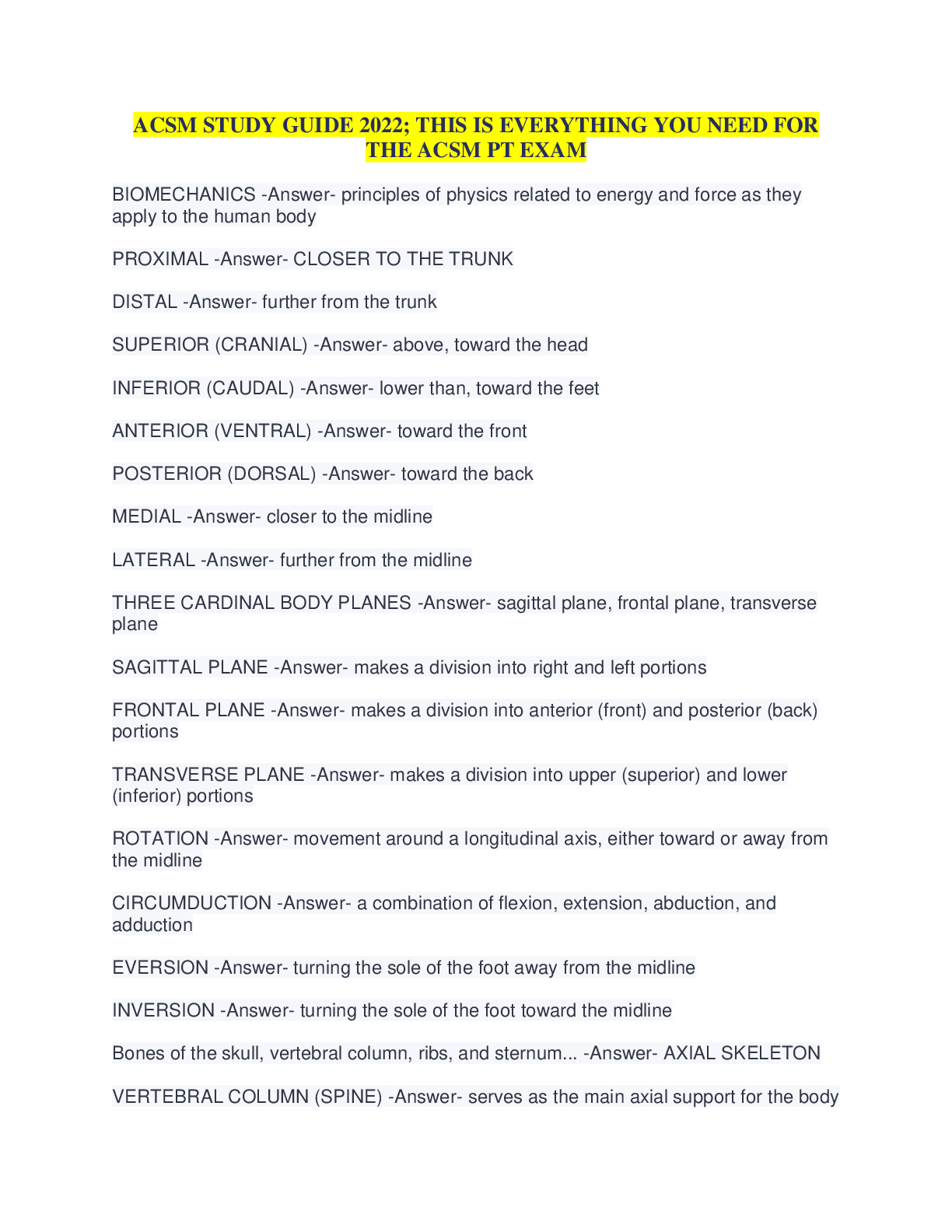
Reviews( 0 )
Document information
Connected school, study & course
About the document
Uploaded On
Jan 10, 2023
Number of pages
18
Written in
Additional information
This document has been written for:
Uploaded
Jan 10, 2023
Downloads
0
Views
154




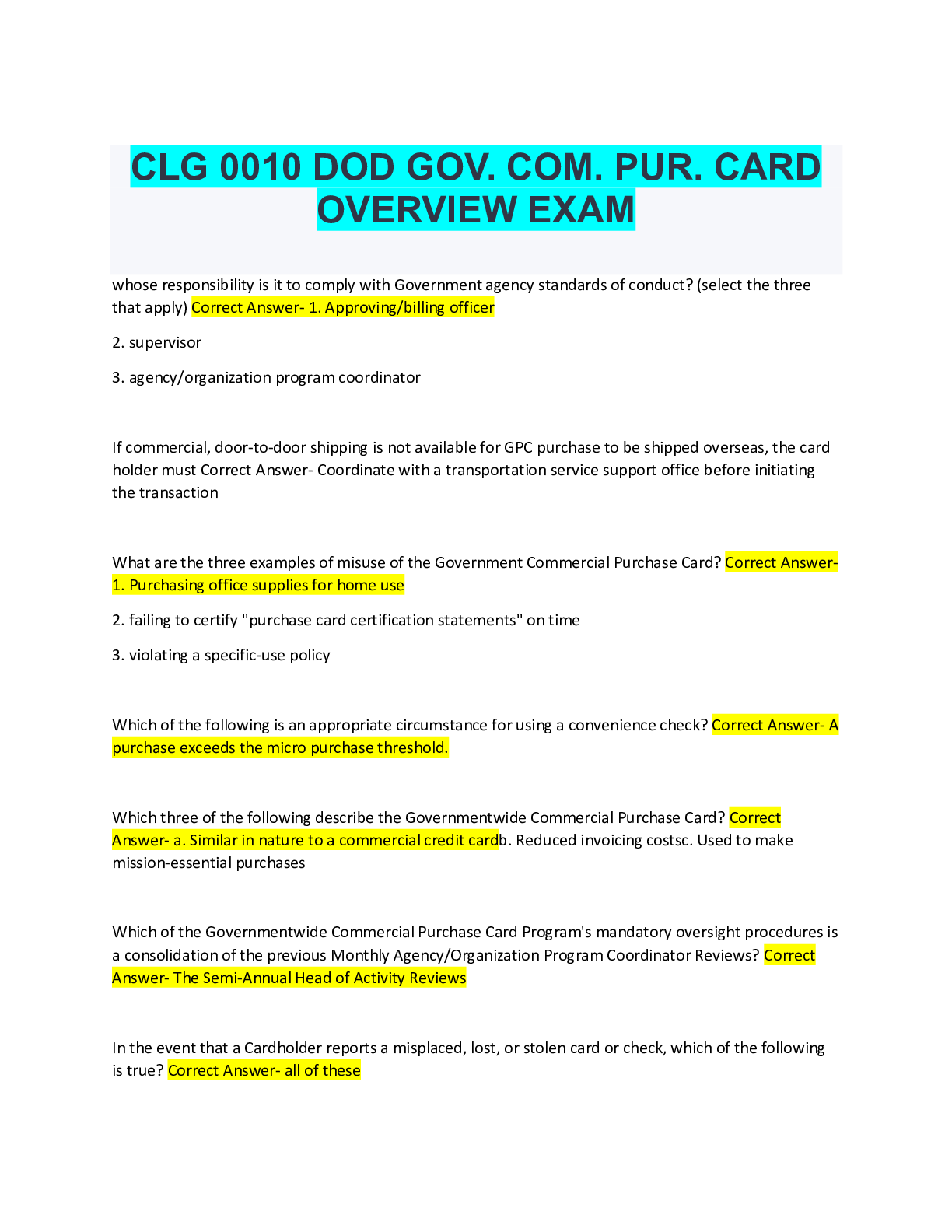


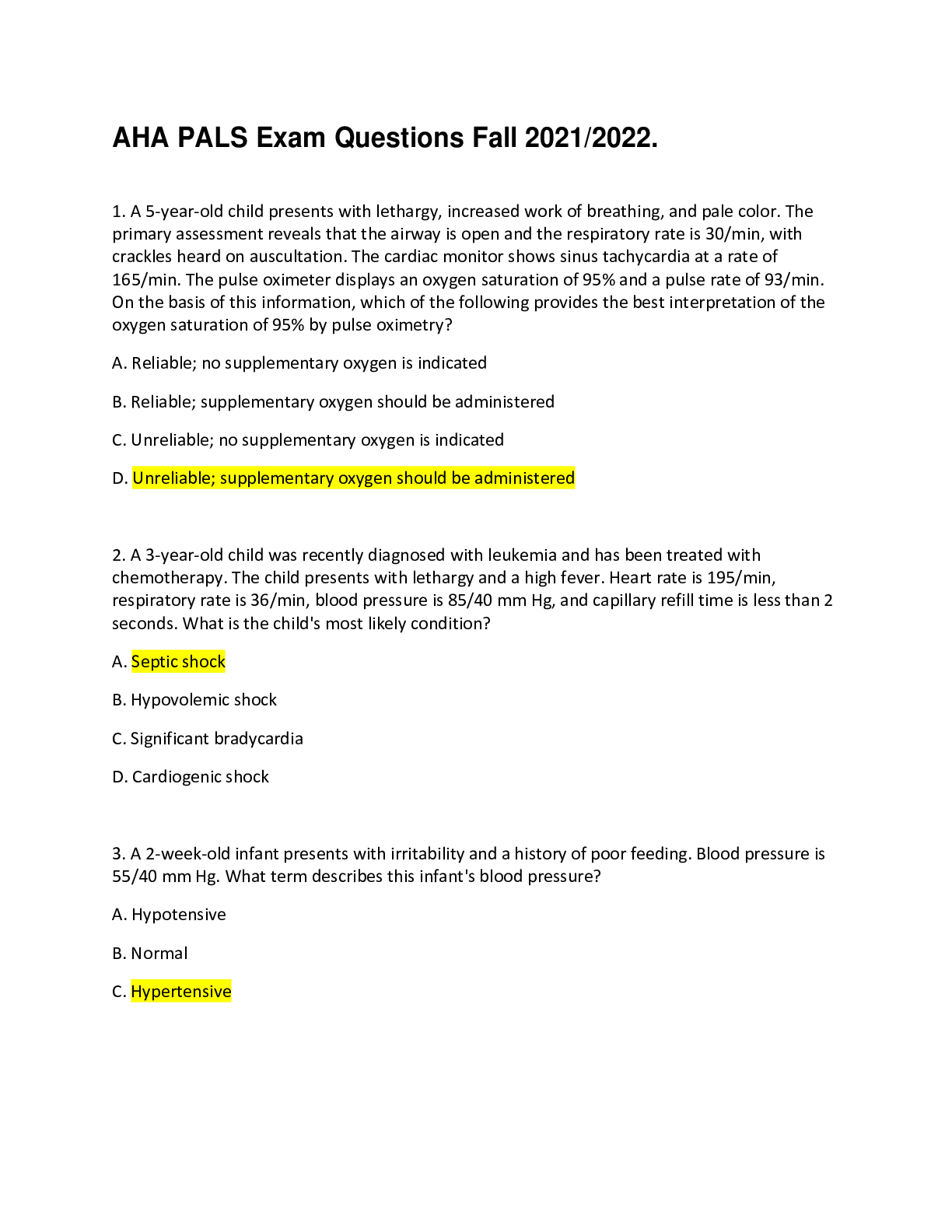

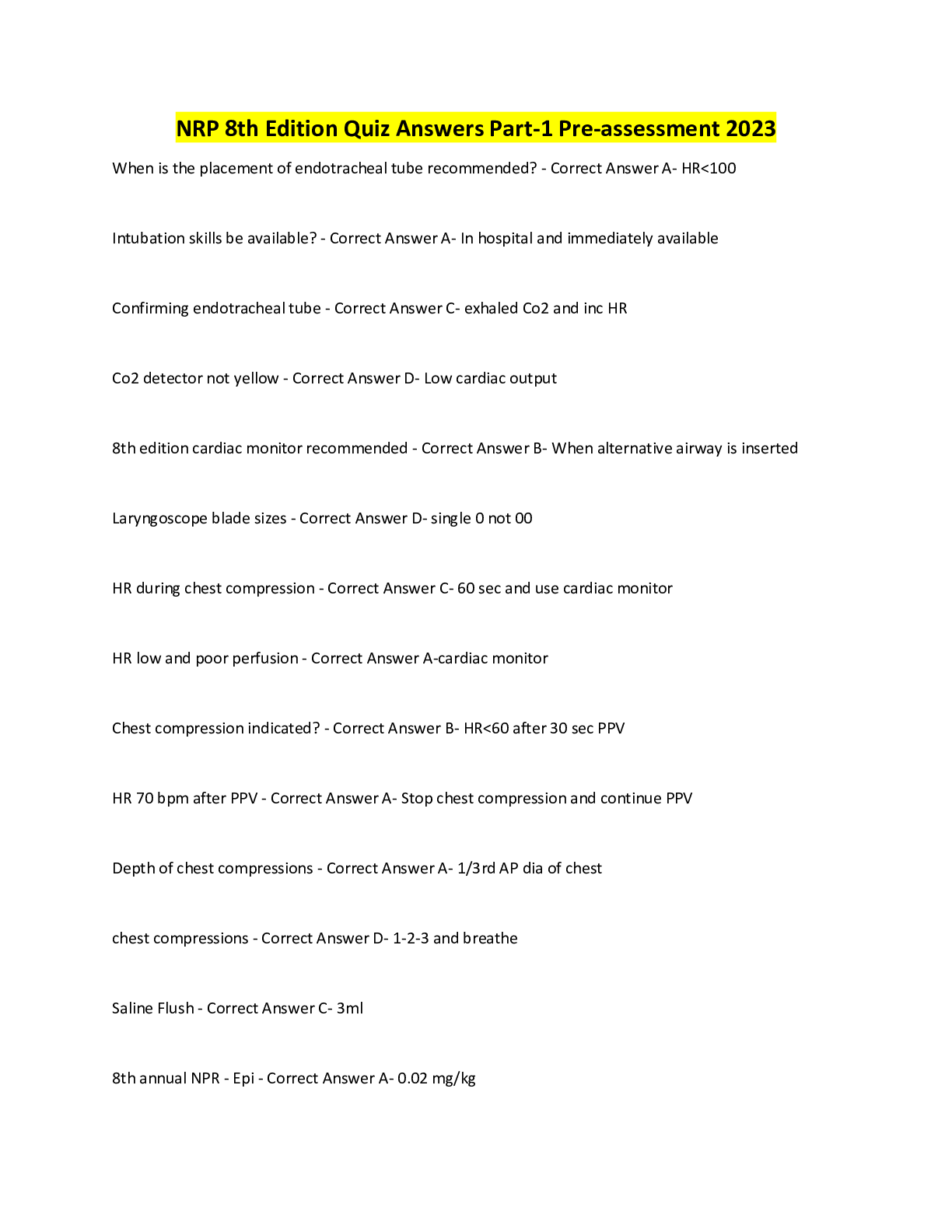

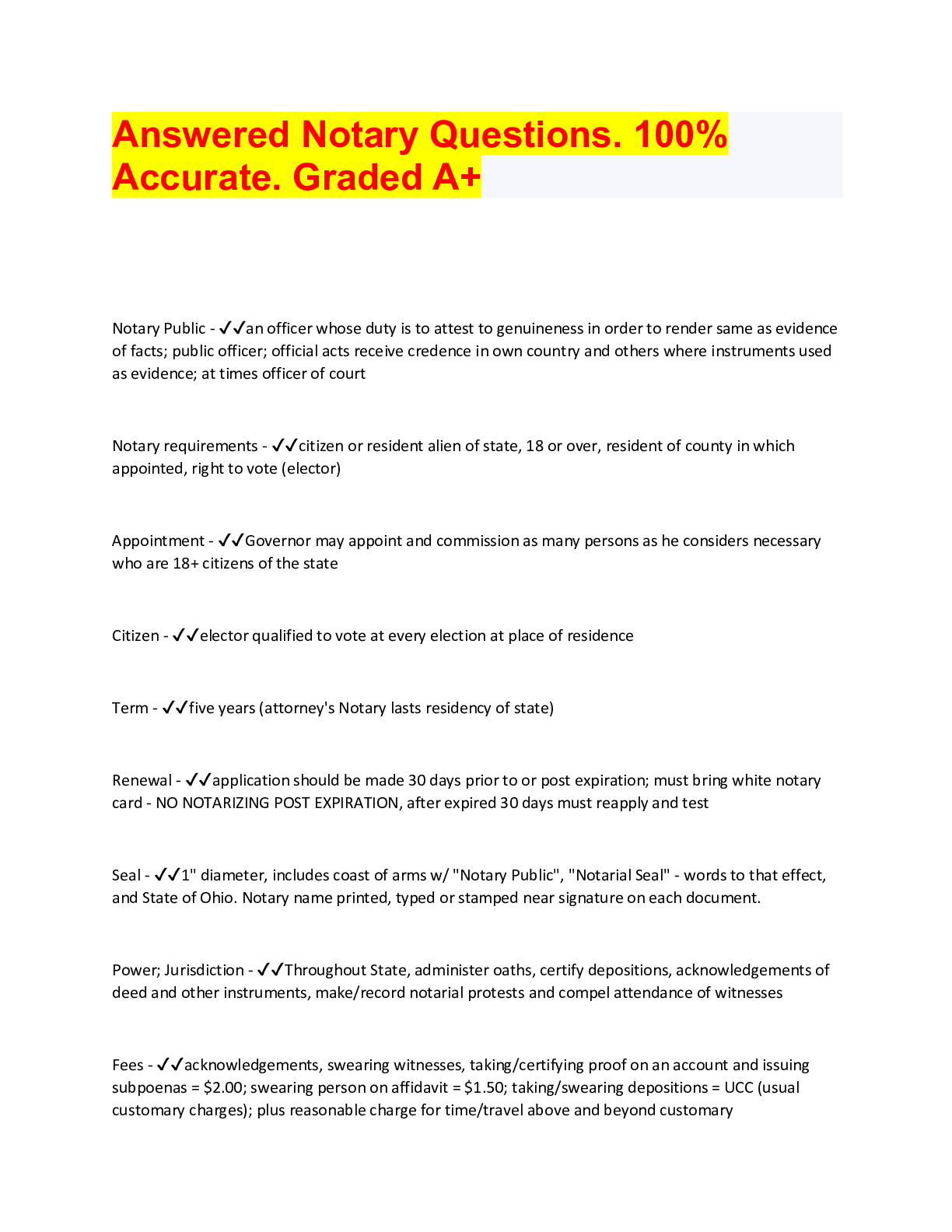

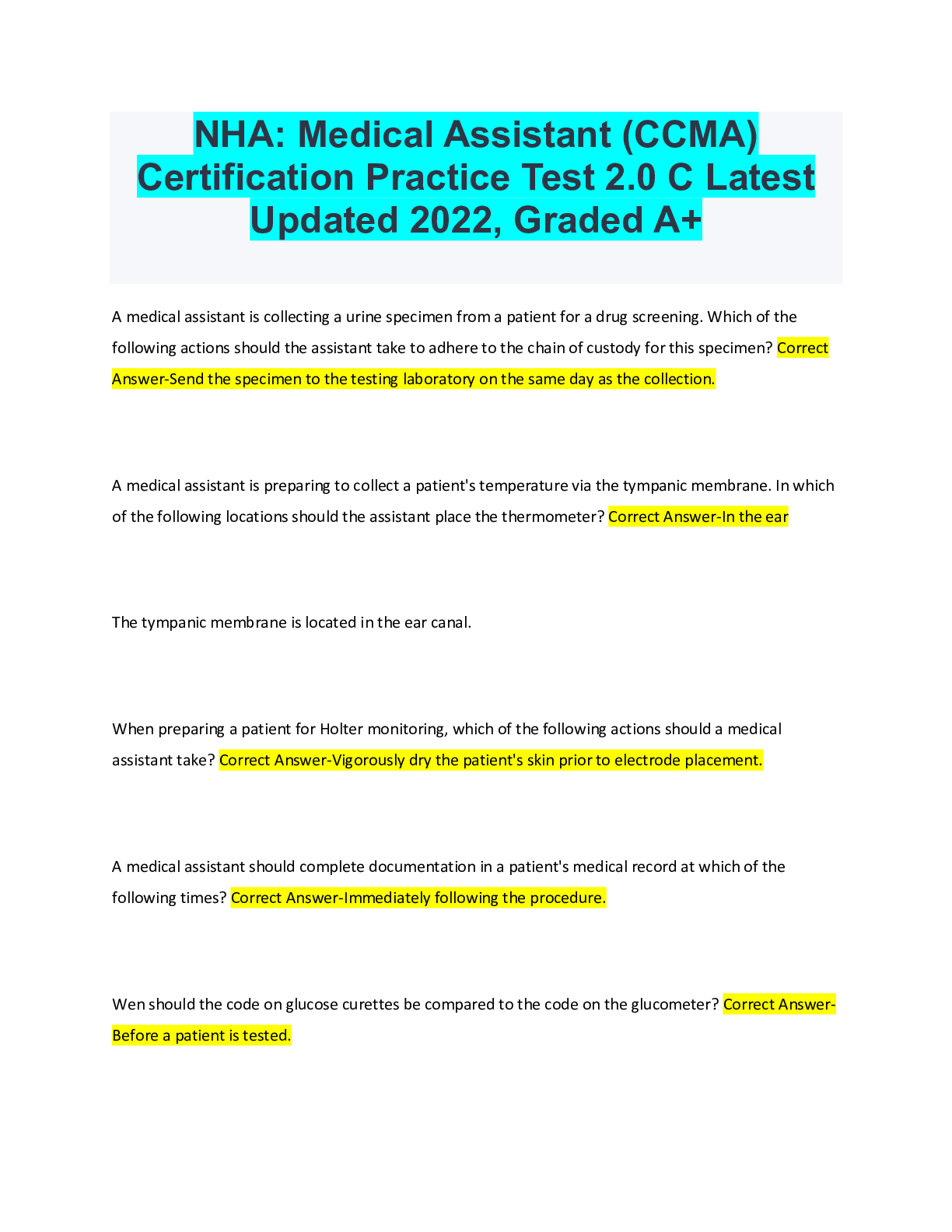
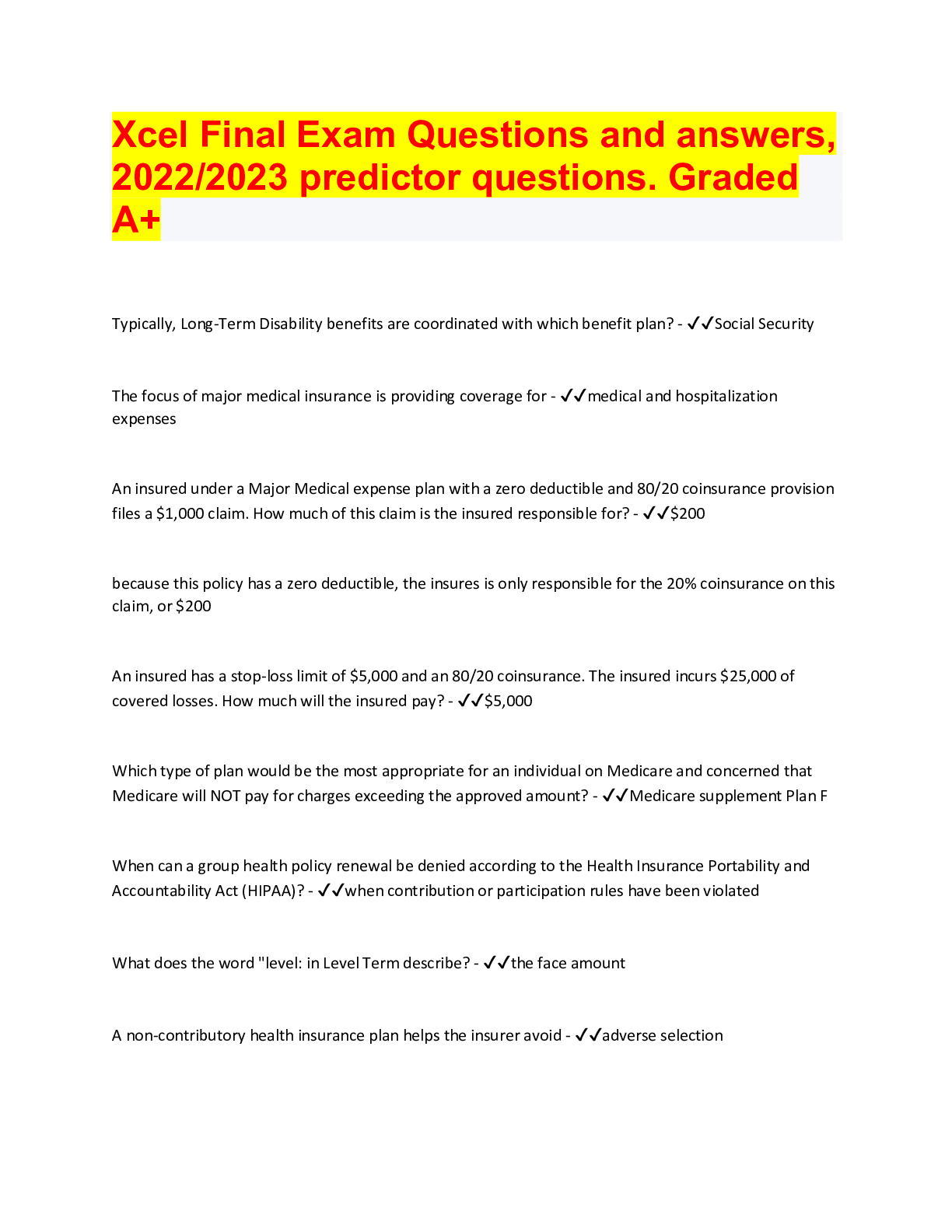
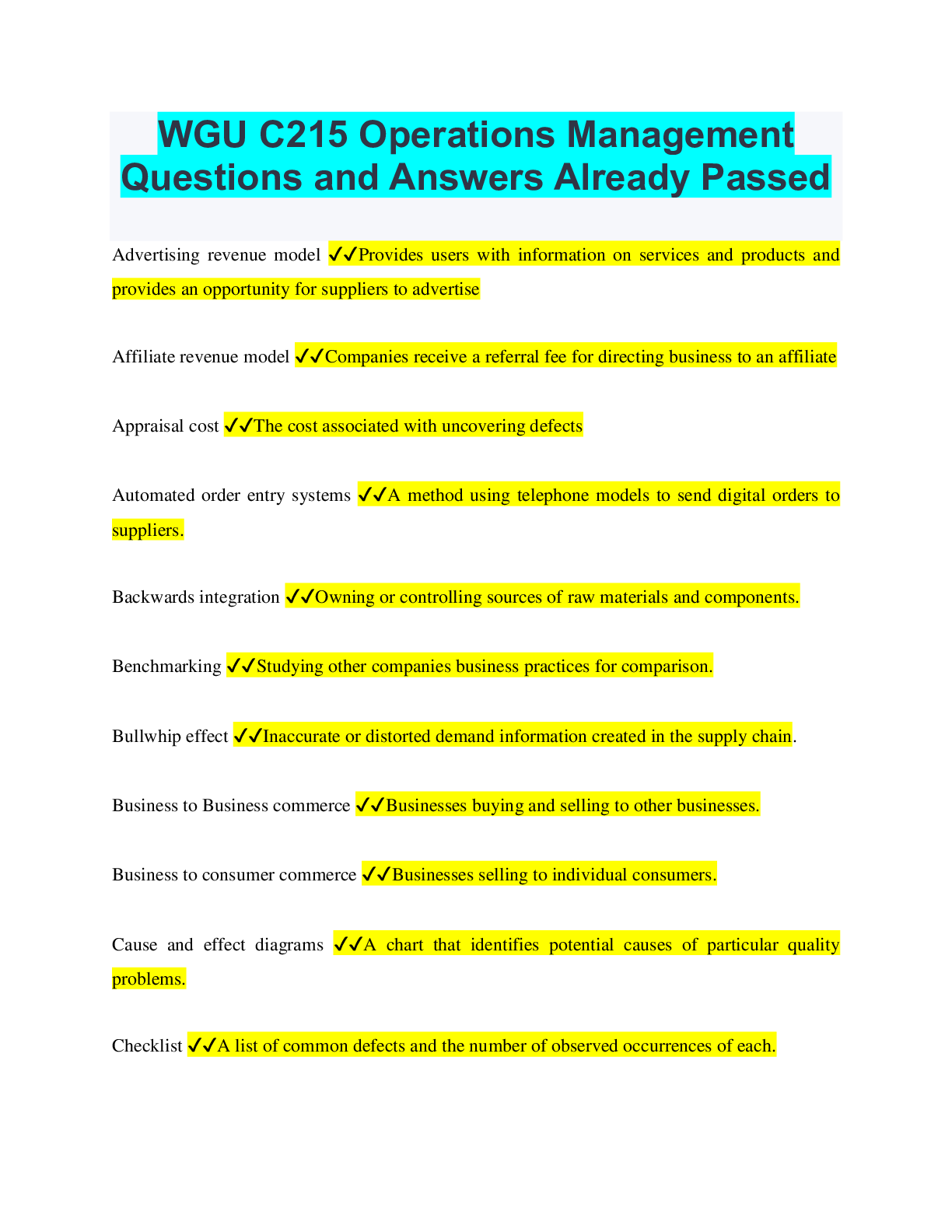
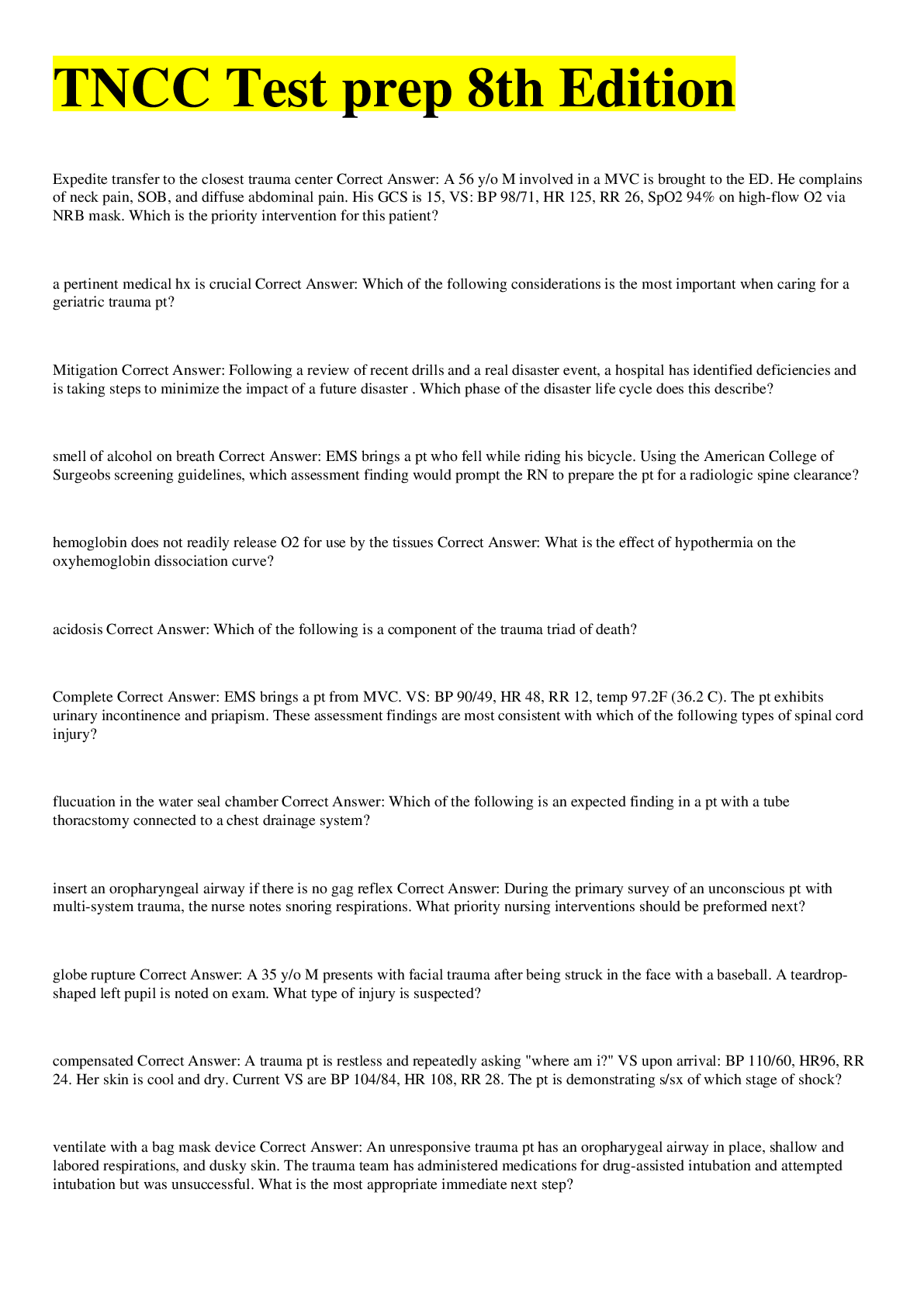

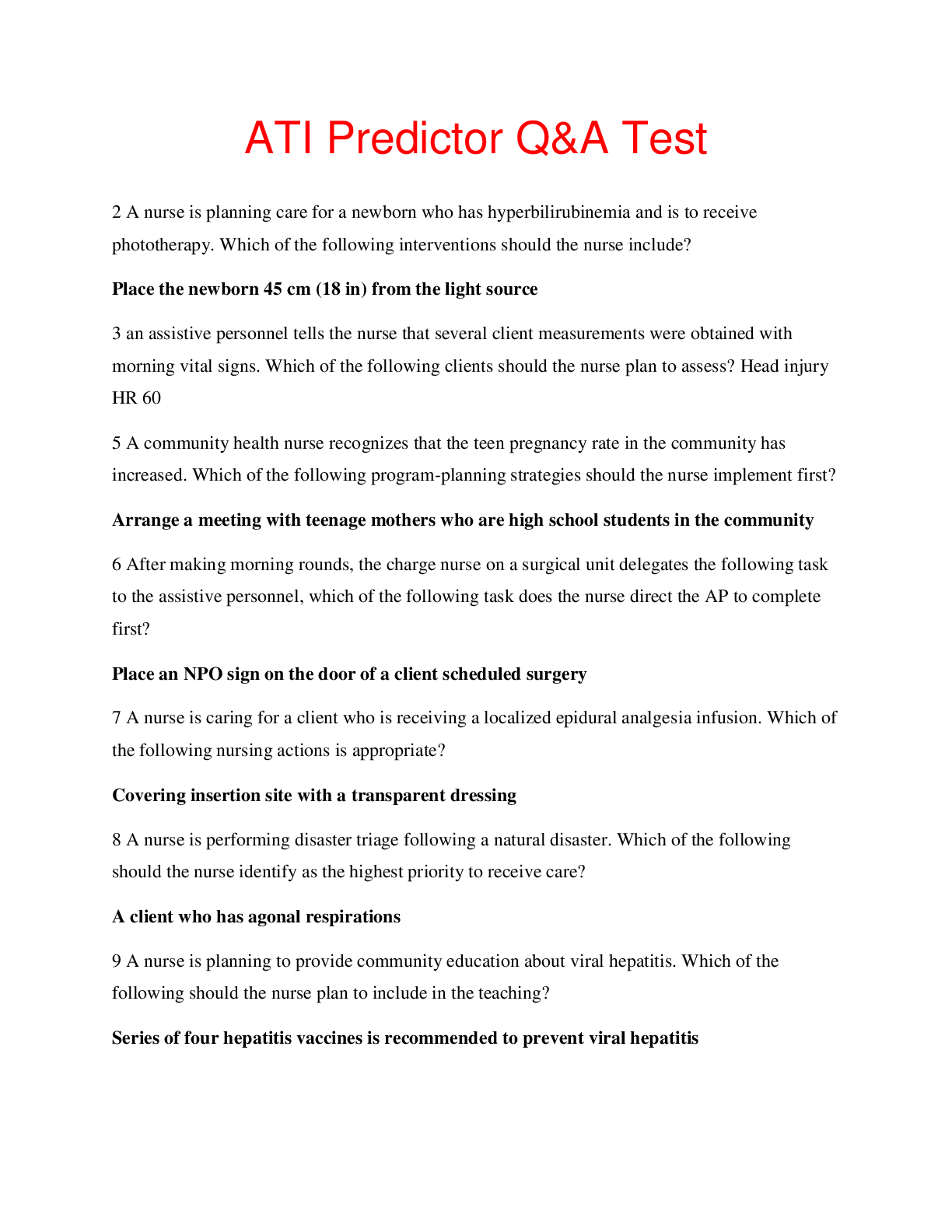
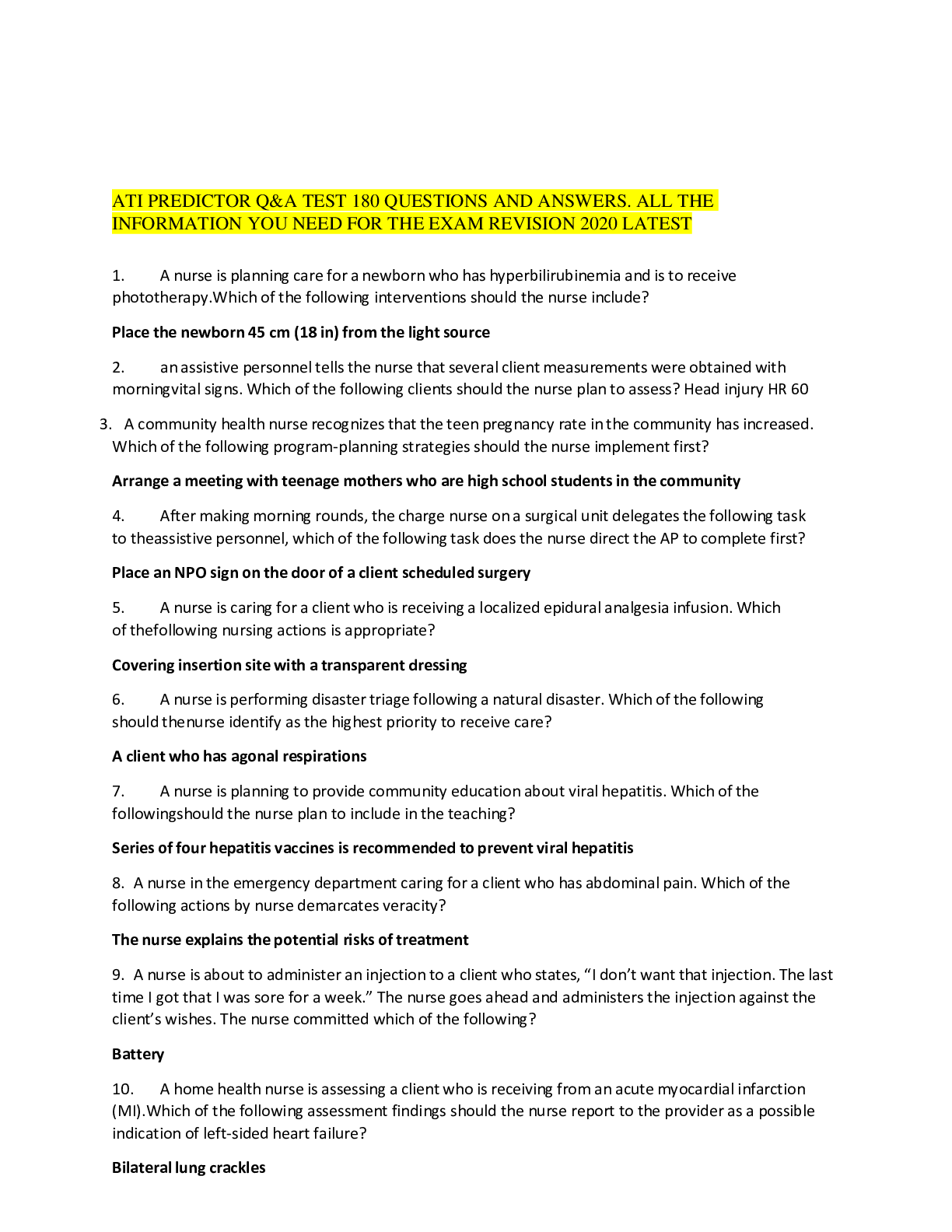
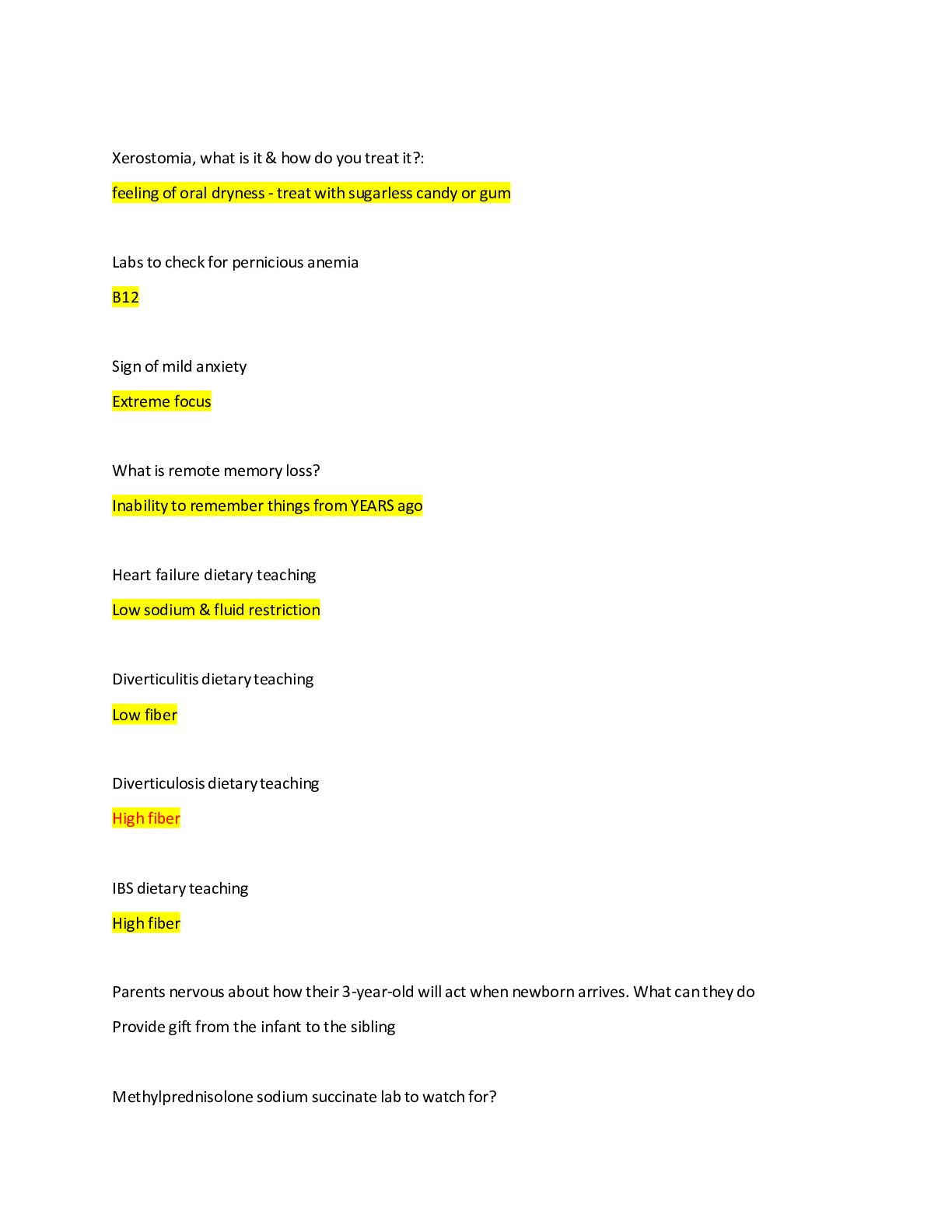
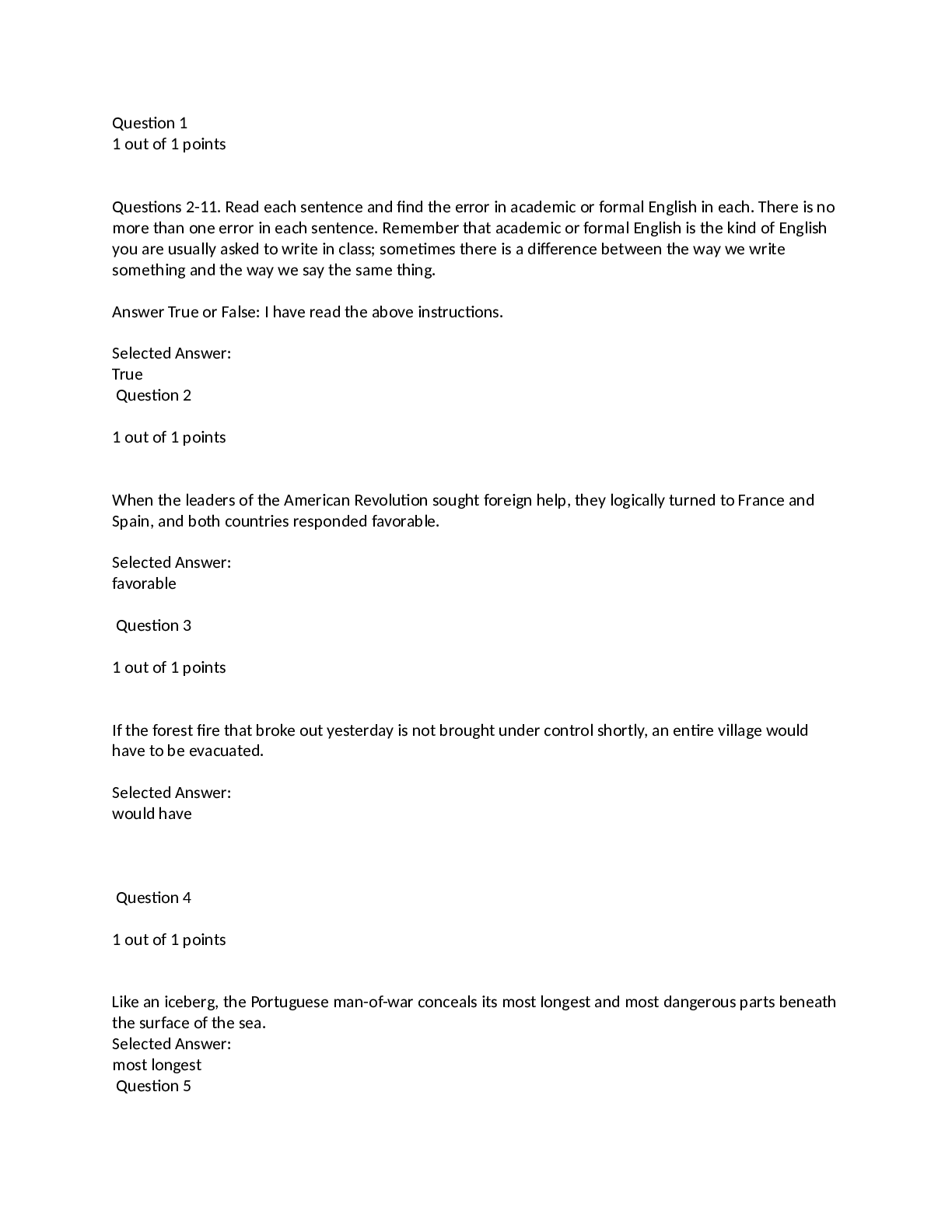
.png)
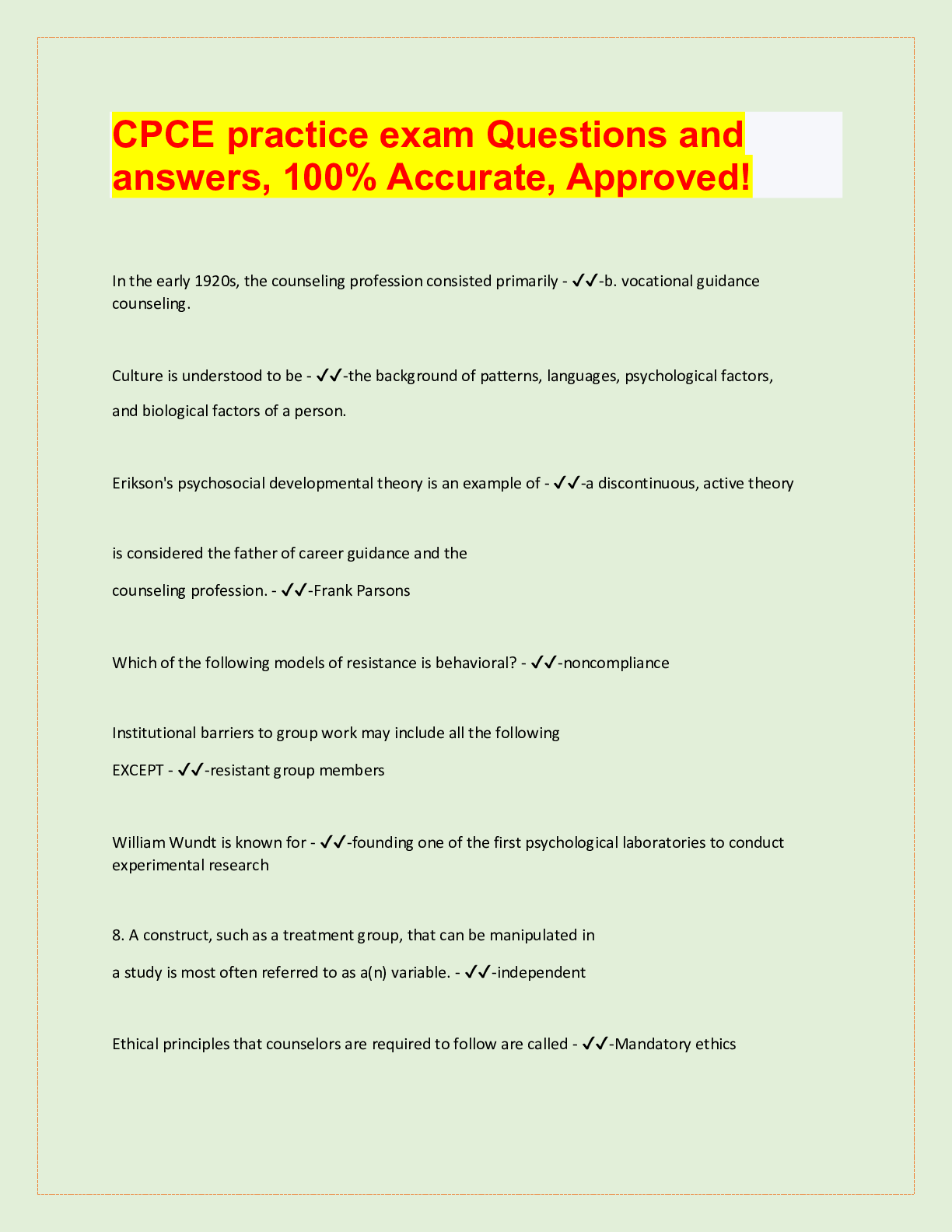
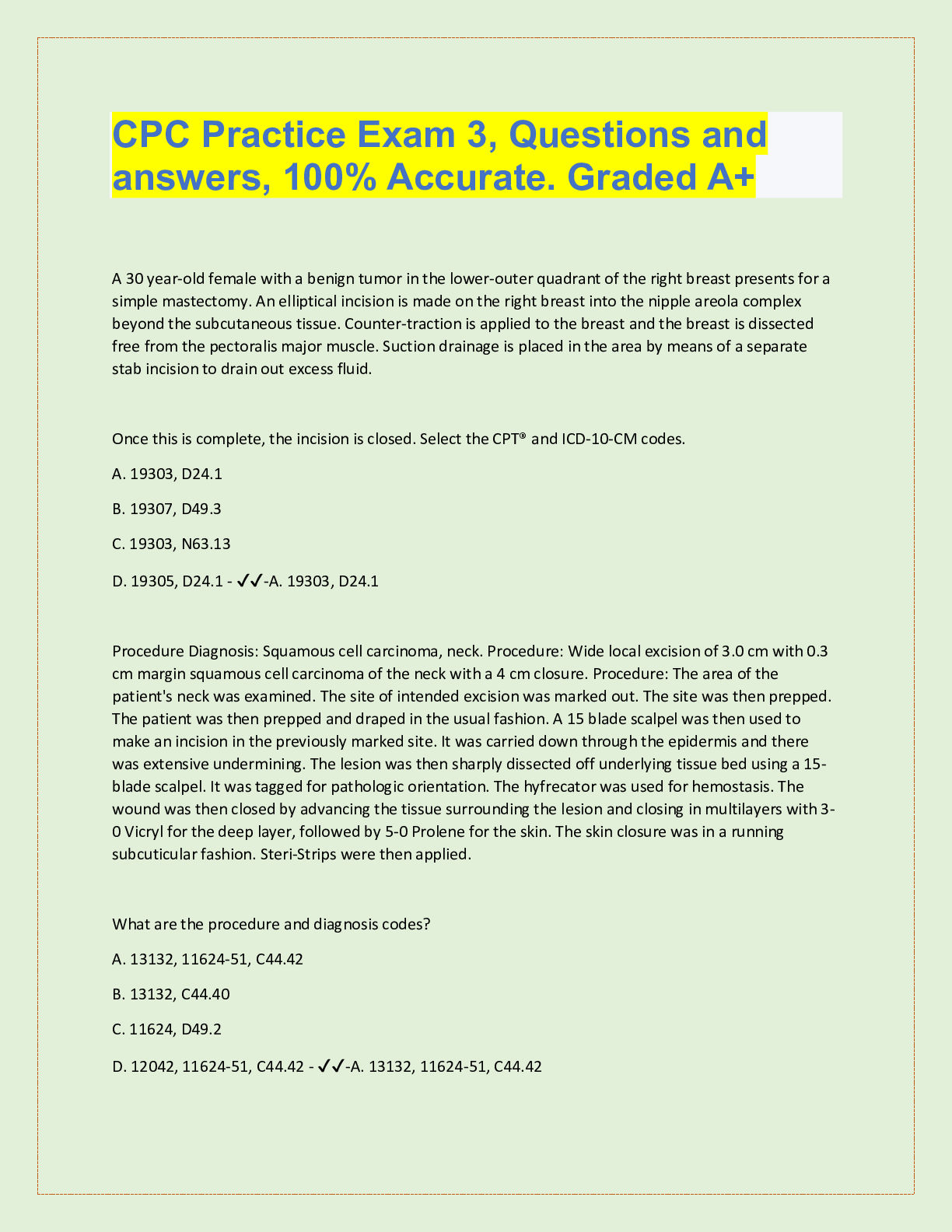
.png)

